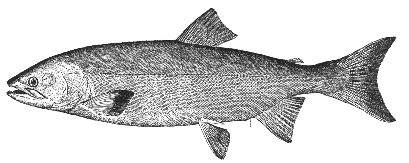Humpback salmon Oncorhynchus gorbuscha (Walbaum) 1792
[Jordan and Evermann, 1896-1900, p. 478.]

Figure 55.—Humpback salmon (Oncorhynchus gorbuscha).
Description—
The humpback is of the familiar salmon outline while living in the sea, the body being deeper than thick, with rounded belly. The head is naked but the body is covered with scales large enough to be seen easily. The dorsal fin stands about midway of the body above the ventrals, and the flaplike adipose fin is over the rear end of the anal fin. It agrees so closely with the Atlantic salmon in all this that the one might easily be taken for the other, were it not that the anal fin of the humpback invariably has 14 rays or more, whereas that of the Atlantic salmon has only about 9 rays. Also, the humpback is a stouter-bodied fish than the Atlantic salmon. The male humpback (like all the Pacific salmons, and the Atlantic salmon to a lesser degree) undergoes a very noticeable change in form in the spawning season, with the body deepening and developing a prominent hump in front of the dorsal fin; the jaws elongating and becoming hooked at the tip and the teeth increasing in size.
Color—
The back and tail of the humpback are bottle green with poorly defined black spots, while it is in the sea. These spots are particularly conspicuous on the tail, where they are oval in outline and as much as a third of an inch in longest diameter. These spots are one of the distinctive marks, whereby the humpback can be distinguished from all other salmons. The sides and belly are silvery, with a faint pinkish tinge. Young humpbacks are unique among salmon in being of practically adult coloration without "parr" marks (p. 122).
Size—
The humpback is the smallest of the Pacific salmons and much smaller than the Atlantic salmon, adults averaging only about 5½ pounds in weight and 20 to 25 inches in length. Males weigh to about 11 pounds and females to about 7½ pounds.
General range—
Pacific coast of North America and of northern Asia, from Oregon northward on the American side. This is the most abundant salmon in Alaska. It runs up fresh rivers to spawn, which it does but once and then dies. It has been introduced in the rivers of Maine.
Occurrence in the Gulf of Maine—
The history of the introduction of this west coast salmon to New England waters is as follows:
Humpback salmon eggs seem first to have been planted in Maine rivers in 1906. In the autumn of 1913 a large consignment of humpback eggs was shipped to the Craig Brook and Green Lake (Maine) hatcheries, and the approximately 7,000,000 fingerlings hatched therefrom were distributed in the Penobscot, Androscoggin, Damariscotta, Dennys, Pleasant, Union, Medomak, Georges, and St. Croix Rivers. A year later some 5,000,000 young fish were liberated. A third plant was made in 1915; a fourth of 6,235,808 fingerlings in 1916; and a fifth of about 1,000,000 in the Dennys and Pembroke Rivers in 1917.[97]
The results of this attempt at acclimatization were first seen in the summer and fall of 1915 when fishermen reported large numbers of mature humpbacks along the Maine coast, and when humpbacks ran in the Dennys, River (where many were caught) from August 15 until September 24, some probably spawning there, for the bodies of spent fish were seen drifting downstream. Humpbacks again entered the Pembroke and Dennys Rivers during August, September, and October of 1917 with a few reported from the Penobscot, St. Georges, Medomak, and St. Croix, the result of the plant of 1915. And at least 2,000 mature fish were seen that summer in the Dennys alone, where many were caught averaging about 5 pounds, and one as heavy as 10 pounds 9 ounces. Definite information is lacking for 1918. But even larger numbers entered the Dennys and Pembroke Rivers in the autumn of 1919 than in 1917, with smaller runs in the Penobscot, Machias, St. Croix, and Medomak Rivers. Enough spawned that year in the Dennys and Pembroke Rivers for the fishculturists of the Bureau of Fisheries to artificially fertilize half a million eggs there. And humpbacks were caught in the weirs in Passamoquoddy and Cobscook Bays during that season.
Adult fish were taken again in the weirs in 1920,[98] and one fish was caught in a weir as far from its native river as Lanesville, Mass. (near Cape Ann)[99] at some time during the summer of 1921.
Large numbers of eggs were collected again from wild fish between 1922 and 1926, the resultant fry being returned to the Dennys and other rivers nearby. Artificial propagation was abandoned then, for it seemed that the species was established.[1] [page 133] But natural reproduction seems not to have been successful enough for the humpback to maintain itself in the few Maine rivers open to it, much less to increase in numbers, for very few have been reported since about 1926 or 1927, and none that we have heard of for some years past.
[97] More detailed accounts of these and successive plantings will be found in the annual reports of the U. S. Commissioner of Fisheries for the years 1914 to 1928.
[98] Reported catch, Washington County, Maine, 1920, 310 pounds.
[99] It was forwarded to the Massachusetts Commissioners as reported by C. E. Grant of Gloucester.
[1] Rept. of U. S. Comm. Fish. (1928), Pt. 1, 1929, p. 379.